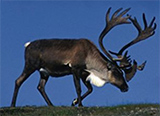séminaire – vendredi 29 septembre 2017
 ‘Ecosystem engineers’ and the conservation of biodiversity
‘Ecosystem engineers’ and the conservation of biodiversity
Patrick Duncan, CNRS-Univ. of La Rochelle Chizé Lab
vendredi 29 septembre 2017
Extinctions of biodiversity have been accelerating since the Pleistocene, and the social and economic consequences of these extinctions for people will accelerate too. However some populations of wild animals have been restored with great success. Understanding the dynamics of these animals in anthroposystems is essential to provide a basis for managing these populations; this requires new scientific frameworks, and new approaches for management, which are emerging. The ‘balance of nature’ paradigm which underlay much of the theory behind conservation of stable, natural systems, has been replaced by a new focus on ‘novel’ ecosystems which are dynamic, under the actions of climate and people. And the population ecology of animals is being rejuvenated, an exciting perspective for applied ecology (‘écologie appliquée’).
Since the impact of people on our anthroposystems is ubiquious and increasingly powerful, management for conservation is generally inevitable. Some species need more attention than others; large herbivores (LH) are species of particular importance for the dynamics and functioning of ecosystems (‘keystone species’). Many of the LH populations in developing countries need saving, while in developed countries many have been restored, and some are invasive.
The impact of LH is density dependent, so we need to understand the processes limiting their populations, and driving their evolution. It is fashionable to say that natural processes are now of minor importance, since the world is driven by people; this is not true everywhere, even in Europe. The old concepts (‘top-down’ or ‘bottom-up’) are being replaced by better ones which take into account the effects of body size and interactions between ‘top-down’ and ‘bottom-up’ processes: the Hopcraft (et al. 2011) model is a useful conceptual framework for savanna systems, but it needs the development of a quantitative version (see Legagneux & al. 2014 for the tundra).
Moving forward: managing LH populations is in its infancy. Management of some birds, in particular Geese, could provide a useful model for a European initiative to improve management of LH. More interactions between the main stakeholders are needed, to identify the key issues and develop co-constructed obvectives for the management of LH. Since the long term consequences of our use of the Earth are not yet understood, wild places can not only contribute to the conservation of LH and the rest of wildlife, but also provide ‘controls’ for our ‘experiments’ of managing nature for food, fibres etc.; ‘rewilding’ with extinct LH is an interesting idea in this context.
- extrait:
- lien_externe:
- kc_data:
- a:8:{i:0;s:0:"";s:4:"mode";s:0:"";s:3:"css";s:0:"";s:9:"max_width";s:0:"";s:7:"classes";s:0:"";s:9:"thumbnail";s:0:"";s:9:"collapsed";s:0:"";s:9:"optimized";s:0:"";}
- kc_raw_content:
 'Ecosystem engineers' and the conservation of biodiversity
'Ecosystem engineers' and the conservation of biodiversityPatrick Duncan, CNRS-Univ. of La Rochelle Chizé Lab
vendredi 29 septembre 2017
Extinctions of biodiversity have been accelerating since the Pleistocene, and the social and economic consequences of these extinctions for people will accelerate too. However some populations of wild animals have been restored with great success. Understanding the dynamics of these animals in anthroposystems is essential to provide a basis for managing these populations; this requires new scientific frameworks, and new approaches for management, which are emerging. The 'balance of nature' paradigm which underlay much of the theory behind conservation of stable, natural systems, has been replaced by a new focus on 'novel' ecosystems which are dynamic, under the actions of climate and people. And the population ecology of animals is being rejuvenated, an exciting perspective for applied ecology ('écologie appliquée').
Since the impact of people on our anthroposystems is ubiquious and increasingly powerful, management for conservation is generally inevitable. Some species need more attention than others; large herbivores (LH) are species of particular importance for the dynamics and functioning of ecosystems ('keystone species'). Many of the LH populations in developing countries need saving, while in developed countries many have been restored, and some are invasive.
The impact of LH is density dependent, so we need to understand the processes limiting their populations, and driving their evolution. It is fashionable to say that natural processes are now of minor importance, since the world is driven by people; this is not true everywhere, even in Europe. The old concepts ('top-down' or 'bottom-up') are being replaced by better ones which take into account the effects of body size and interactions between 'top-down' and 'bottom-up' processes: the Hopcraft (et al. 2011) model is a useful conceptual framework for savanna systems, but it needs the development of a quantitative version (see Legagneux & al. 2014 for the tundra).
Moving forward: managing LH populations is in its infancy. Management of some birds, in particular Geese, could provide a useful model for a European initiative to improve management of LH. More interactions between the main stakeholders are needed, to identify the key issues and develop co-constructed obvectives for the management of LH. Since the long term consequences of our use of the Earth are not yet understood, wild places can not only contribute to the conservation of LH and the rest of wildlife, but also provide 'controls' for our 'experiments' of managing nature for food, fibres etc.; 'rewilding' with extinct LH is an interesting idea in this context.
- titre:
- 'Ecosystem engineers' and the conservation of biodiversity
- intervenant:
- Patrick Duncan
- date:
- vendredi 29 septembre 2017
